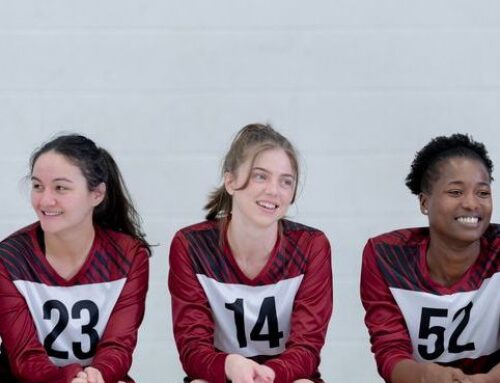Get our exclusive report. Download the iSport360 Club Switching Report Here – For Club Admins, Rec Leaders and Coaches.
Pros and Cons of Social Media Use for Young Athletes
Are you worried about the amount of time your student-athlete spends on social media? Here, Dr. Charron Sumler, TrueSport Expert and Assistant Director of Sport Psychology and Wellness Services at The Ohio State University, shares the stats on social media, along with the pros and cons of usage for young athletes. The bottom line: Social media is a valuable tool, and it isn’t inherently good or bad, which means you can help your athlete harness its positive power!
What you need to know about social media use and youth
According to the Pew Research Center, 93 percent of teens use YouTube, while Instagram, TikTok, and Snapchat are used by roughly 60 percent of the teen population. And that means social media usage is now the norm, says Sumler. “If your teen isn’t using social media, it’s now a conscious choice,” says Sumler. If your teen is using social media, Sumler doesn’t recommend banning them from all social platforms.
However, we know that social media usage and the associated risks to mental health for young people is such a serious issue that the U.S. Surgeon General recently called for a warning label to be put on the platforms when they’re used by minors. While no such law has been enacted, caregivers are understandably concerned about how to best protect their children.
Pros of Social Media Use
- Friendship and community building: “ Social media helps facilitate communication and information sharing. It’s where their friends are,” says Sumler. “It’s now a space where they communicate, build communities, and share things with each other.” For athletes who are away from sport due to illness or injury, social media can be their primary source of connection to their friend groups. And for marginalized youth, social media can provide them with access to communities that they wouldn’t otherwise be exposed to, says Sumler. That can be life changing.
- Fun and entertainment: “TikTok is like watching TV for many young people now,” says Sumler. “Parents generally wouldn’t worry about an athlete who watches an hour or two of television every day, assuming they were able to keep up with their school and training obligations, so we do need to understand that for this generation, many of them get their entertainment from social media apps instead of cable TV.”
- Information: “From a performance standpoint, athletes are certainly talking about being able to use social media to gain information about their sport, including new training techniques and competition strategies,” says Sumler. “Athletes can stay updated on what’s trending in their sport and with professional athletes, which keeps them engaged and learning.”
- Name/Image/Likeness considerations: “Being able to create and publicize a brand online is a positive,” says Sumler. As NIL deals are now allowed in college sports, creating a strong social media presence from a young age may actually help some athletes obtain better deals with sponsors, and allow them to mature on the platforms before they’re expected to be on them as professional athletes.
Cons of Social Media
- Self-esteem/body issues: Research has found that social media can lead to body dissatisfaction, disordered eating behaviors, social comparison, and low self-esteem, particularly for young women. A whopping 46 percent of teens reported social media made them feel worse about themselves. “Comparison can be a really big problem, especially for athletes,” says Sumler. “And comparison on social media is especially problematic because on these platforms, we’re really only seeing people’s highlight reel rather than their real life.”
- Artificial Intelligence and filters providing skewed images: With the use of AI on the rise and filters becoming nearly impossible to detect, athletes are faced with images that have been heavily filtered or have been completely artificially generated, which can lead to feelings of comparison and inadequacy for young athletes, says Sumler.
- Misinformation: Not all information on social media is accurate or positive, says Sumler. This is especially true in the health/wellness/nutrition space, where researchers found that of 700 posts done on those topics by well-known influencers, 45 percent contained inaccurate information, and nine out of 10 were considered ‘low quality’ in terms of the information they provided.
- Time: Put simply, social media could be taking up your athlete’s valuable time. According to Gallup Polls, teens spend on average 4.1 hours up to 5.8 hours per day using social media. While some social media usage is arguably fine, spending all of their free time on it takes away from making real life connections, keeping up with school work, or even making time for self-care practices that will make them feel better recovered, says Sumler. It can also cut into time better spent sleeping—one study found that one in three adolescents use their phones (typically on social media) until after midnight on weekdays.
- Diminished coping skills: Often, teens turn to their phones to be distracted from real life, says Sumler. “This diminishes the ability to learn coping skills because it allows you to distract yourself very quickly,” she says. “It doesn’t give you the room to practice what to do when you’re bored, what to do when you’re feeling down. That immediate relief of scrolling diminishes those coping capabilities, and all teens need to develop those capacities.”
Tips for Navigating Social Media Usage
It’s not about getting rid of social media. “We’re now in a place where there aren’t necessarily ways to avoid social media by trying to block it or restrict it, so, how do we integrate it in a healthy way?” Sumler asks. As you start to talk to your student-athlete about social media, make it clear that you’re not going to try to block their use. Instead, express that you simply want to have a conversation about the best way to use it.
Open the conversation with curiosity and ask your athlete why they want to use social media. Express interest in who they’re following and what information and content they’re consuming, says Sumler. Start the conversation from a positive place of interest versus concern to encourage an honest, open discussion with your athlete. Have conversations about filters and AI-generated images, and help your athlete understand that what they see isn’t necessarily true to real life.
It can also be helpful to set boundaries for the whole family. While many teens are now on social media for hours every day, so are parents, says Sumler. Many parents of teens spend time on Instagram, Facebook, and TikTok. And because children and teens model their behavior after that of their caregivers, your own social media usage needs to be part of the discussion. If you’re not allowing your athlete to be on social media while at the dinner table, your phone should also be in the other room.
Takeaway
Social media use for teens is nearly inevitable, but it doesn’t have to be a negative part of their lives. You can help your athlete harness the benefits, set boundaries, and role model healthy usage.
About TrueSport
TrueSport®, a movement powered by the experience and values of the U.S. Anti-Doping Agency, champions the positive values and life lessons learned through youth sport. Backed by U.S. Congressional mandate, TrueSport inspires athletes, coaches, parents, and administrators to change the culture of youth sport through active engagement and thoughtful curriculum based on cornerstone lessons of sportsmanship, character-building, and clean and healthy performance, while also creating leaders across communities through sport.
For more expert-driven articles and materials, visit TrueSport’s comprehensive collection of resources.
This content was reproduced in partnership with TrueSport. Any content copied or reproduced without TrueSport and the U.S. Anti-Doping Agency’s express written permission would be in violation of our copyright, and subject to legal recourse. To learn more or request permission to reproduce content, click here.
You can link back to the TrueSport article beginning 10/1/2024 at: https://truesport.org/mental-wellness/social-media-young-athletes/
Learn more or request a demo of our youth sports software that is helping teams improve communication, organization and player development.
September 24, 2024





